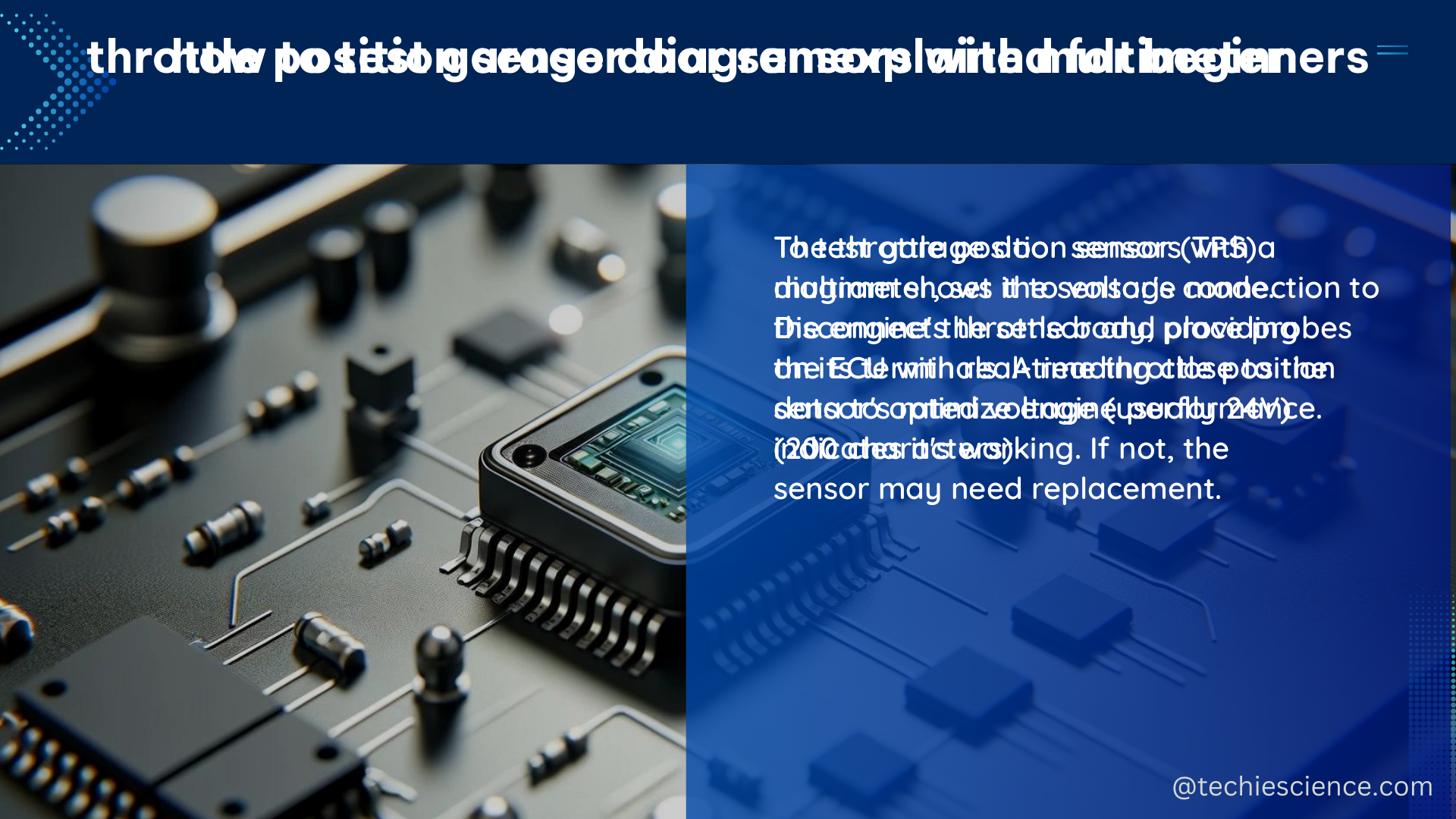The throttle position sensor (TPS) is a crucial component in modern engine control systems, responsible for monitoring and relaying the throttle position to the engine control unit (ECU). This information significantly influences crucial aspects of engine performance, such as fuel injection and air-fuel ratio, ensuring efficient engine operation.
Understanding the Throttle Position Sensor
A TPS typically consists of a variable resistor or potentiometer linked to the throttle shaft. As the throttle opens or closes, the resistance in the TPS changes, which the ECU utilizes to determine the exact position of the throttle and adjust various engine parameters accordingly.
Potentiometer-based TPS
This type of TPS consists of a variable resistor that is connected to the throttle shaft. As the throttle is opened, the resistance across the potentiometer changes, which provides a voltage signal to the ECU. The ECU then uses this signal to determine the position of the throttle and adjust fuel injection accordingly.
The potentiometer-based TPS typically has three wires:
1. Signal Wire: This wire carries the voltage signal that represents the throttle position.
2. Ground Wire: This wire provides a reference ground for the sensor.
3. Power Wire: This wire supplies the necessary voltage (usually 5V) to the sensor.
The voltage signal from the TPS can range from 0.5V (closed throttle) to 4.5V (wide-open throttle), with a typical operating range of 0.5V to 4.5V.
Hall Effect-based TPS
This type of TPS uses a magnetic field to detect the position of the throttle. A small magnet is mounted on the throttle shaft, and as the shaft rotates, it passes over a Hall effect sensor, which generates a voltage signal. The ECU then uses this signal to determine the position of the throttle and adjust fuel injection accordingly.
The Hall effect-based TPS typically has three wires:
1. Signal Wire: This wire carries the voltage signal that represents the throttle position.
2. Ground Wire: This wire provides a reference ground for the sensor.
3. Power Wire: This wire supplies the necessary voltage (usually 5V) to the sensor.
The voltage signal from the Hall effect-based TPS can range from 0.5V (closed throttle) to 4.5V (wide-open throttle), with a typical operating range of 0.5V to 4.5V.
Throttle Body and TPS Installation

The TPS is typically installed on the throttle body of the engine. The throttle body is a component responsible for regulating the airflow into the engine. The TPS is strategically positioned on the throttle body in a way that allows it to accurately monitor the position of the throttle plate or valve.
The throttle body can be made of various materials, such as aluminum or plastic, and the TPS is usually mounted on the side of the throttle body using screws or bolts. The TPS is connected to the throttle shaft through a linkage or direct connection, ensuring that the sensor accurately tracks the throttle position.
Testing the Throttle Position Sensor
When it comes to testing a TPS, a digital volt meter and a Digital Storage Oscilloscope (DSO) can be used to verify if the sensor is working as intended. The scope and the meter are connected to the signal wire and the ground, and the throttle is swept open and closed. The voltage on the signal wire changes in relationship to the throttle opening, allowing for the contacts for the closed throttle and the throttle positioning sensor to be observed.
During the test, the following parameters should be checked:
1. Voltage Range: The voltage should range from 0.5V (closed throttle) to 4.5V (wide-open throttle).
2. Linearity: The voltage should increase linearly as the throttle is opened.
3. Resistance: The resistance of the TPS should be within the manufacturer’s specifications, typically between 1 kΩ and 6 kΩ.
If the TPS is not functioning within the expected parameters, it may need to be cleaned, adjusted, or replaced.
Maintaining the Throttle Position Sensor
To ensure optimal performance, regular maintenance of the throttle position sensor is essential. It’s a good idea to check the TPS periodically and clean it if necessary. Proper installation and the use of high-quality parts are also crucial for the TPS to operate accurately and reliably.
When cleaning the TPS, it’s important to use a non-abrasive cleaner and avoid getting any dirt or debris inside the sensor. Additionally, it’s essential to ensure that the TPS is properly aligned and secured to the throttle body, as any misalignment can affect the sensor’s accuracy.
Conclusion
The throttle position sensor is a vital component in modern engine control systems, responsible for monitoring and relaying the throttle position to the ECU. There are two main types of TPS: potentiometer-based and Hall effect-based. Regular maintenance, proper installation, and the use of high-quality parts are essential for the TPS to operate accurately and reliably, keeping the engine running smoothly.
References:
– Throttle Position Sensor Diagram – Nevsemi Electronics
– Throttle Position Sensor Testing and Explanation – YouTube
– Throttle Position Sensor Complete Guide – Quarktwin Electronic Parts
– Throttle Position Sensor – Explained – YouTube
– THROTTLE POSITION SENSOR explanation for wiring diagram – YouTube

The lambdageeks.com Core SME Team is a group of experienced subject matter experts from diverse scientific and technical fields including Physics, Chemistry, Technology,Electronics & Electrical Engineering, Automotive, Mechanical Engineering. Our team collaborates to create high-quality, well-researched articles on a wide range of science and technology topics for the lambdageeks.com website.
All Our Senior SME are having more than 7 Years of experience in the respective fields . They are either Working Industry Professionals or assocaited With different Universities. Refer Our Authors Page to get to know About our Core SMEs.